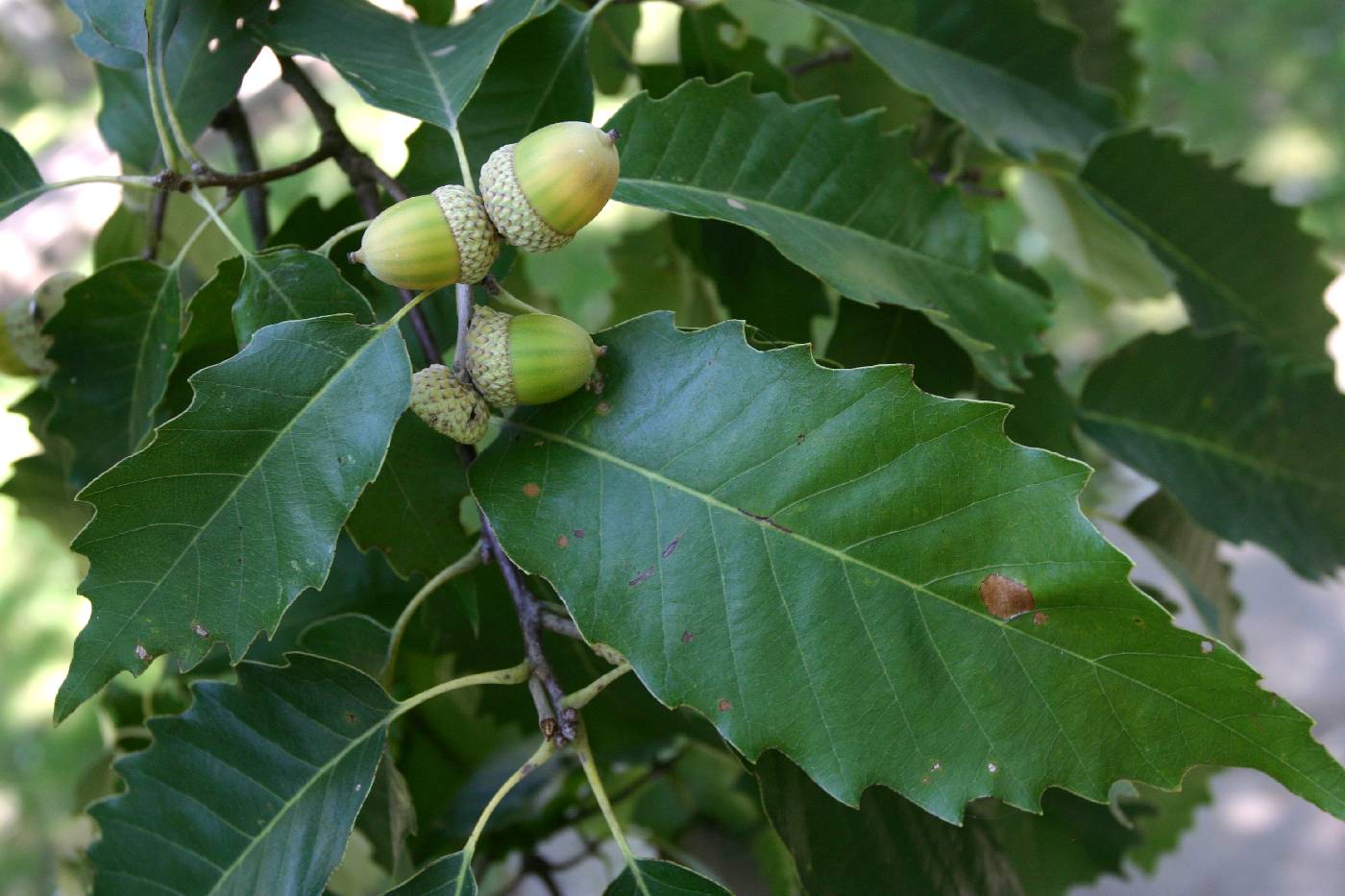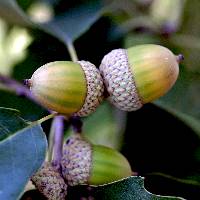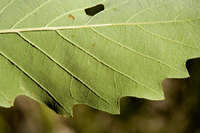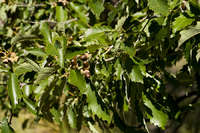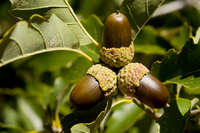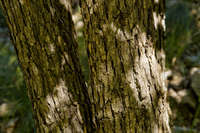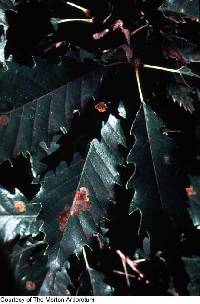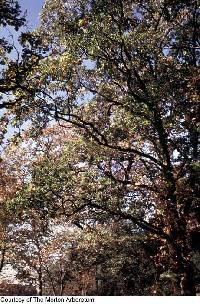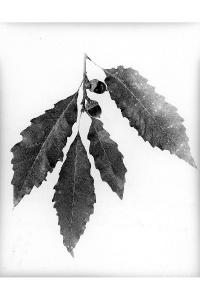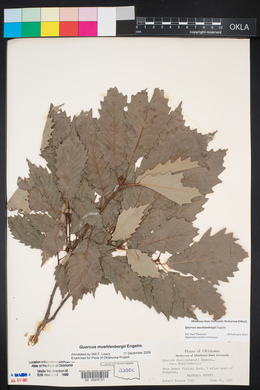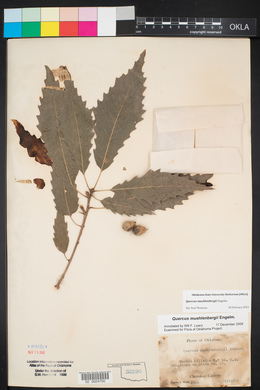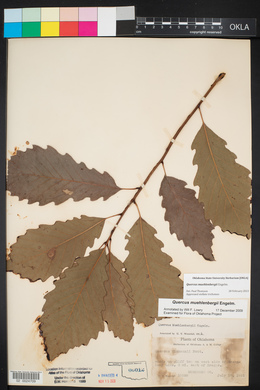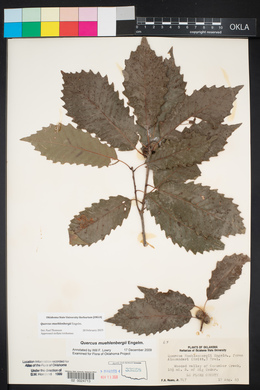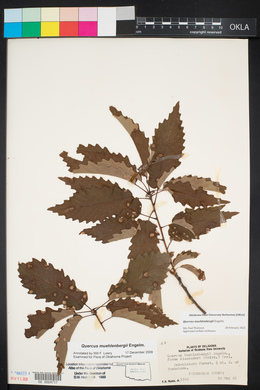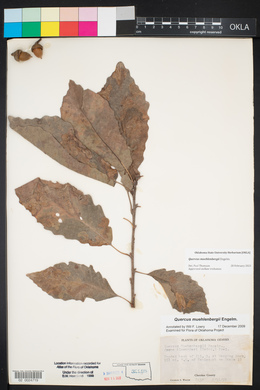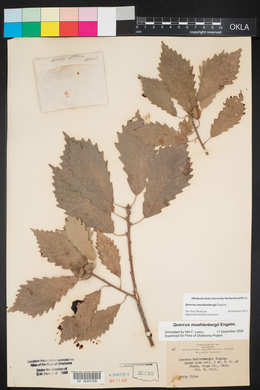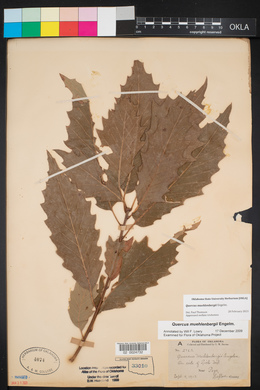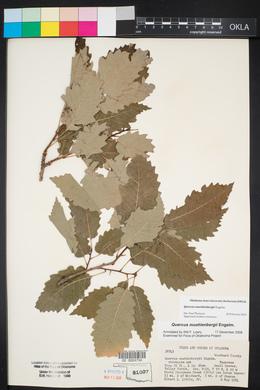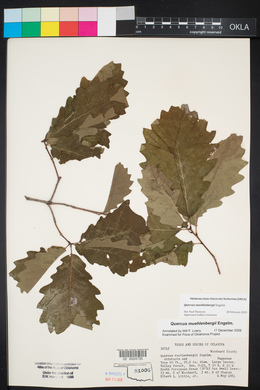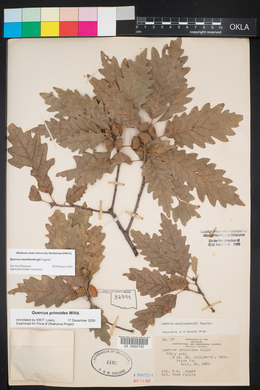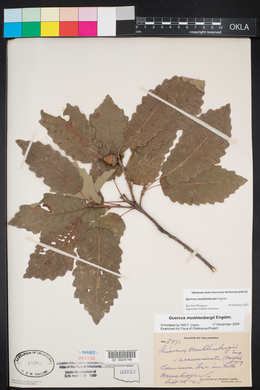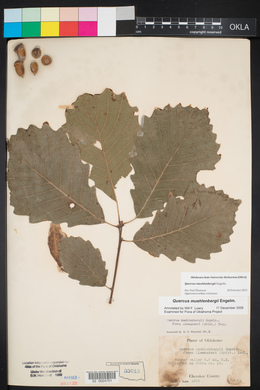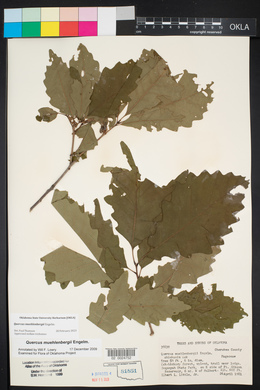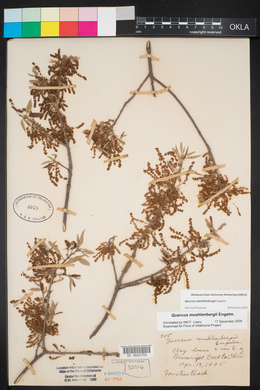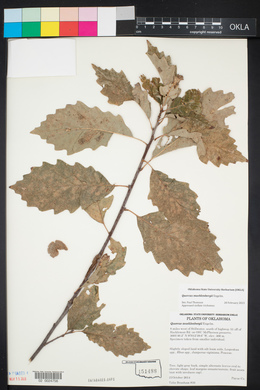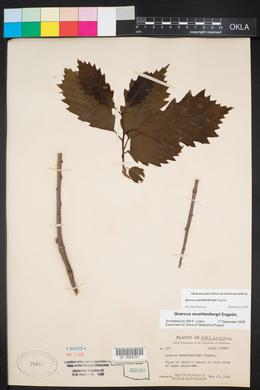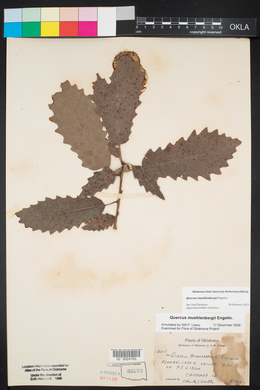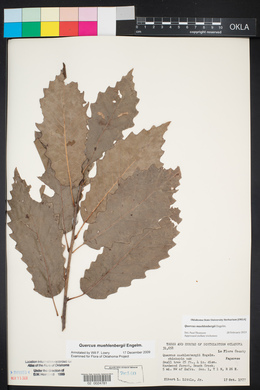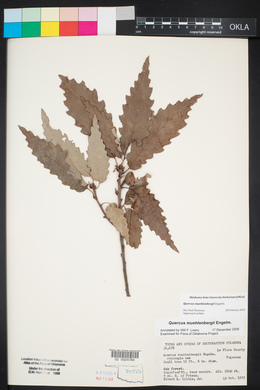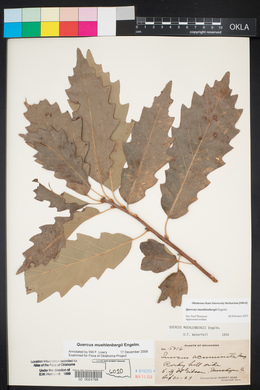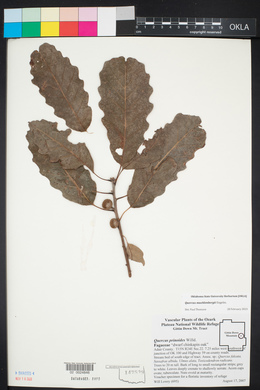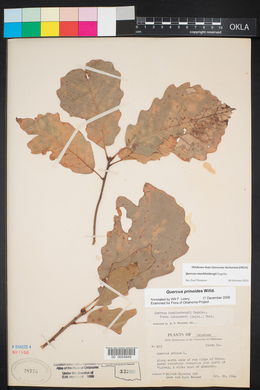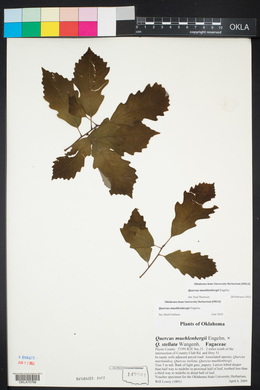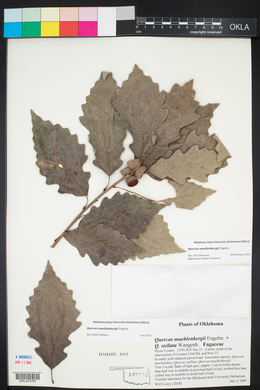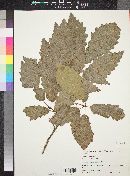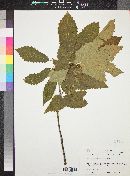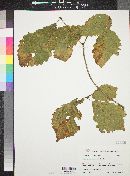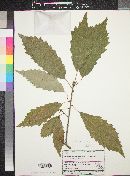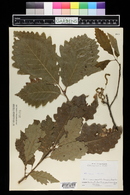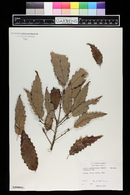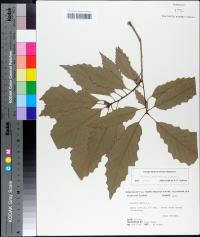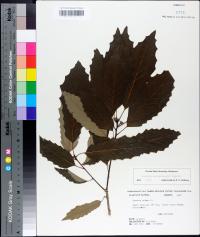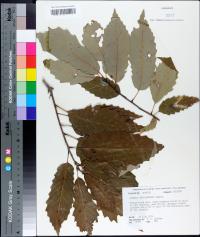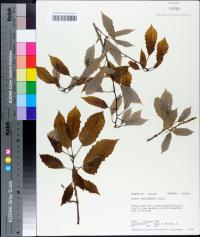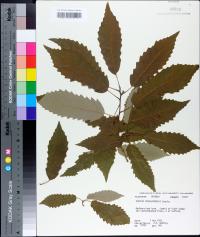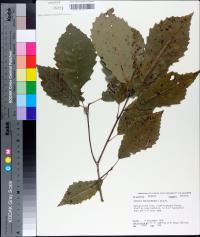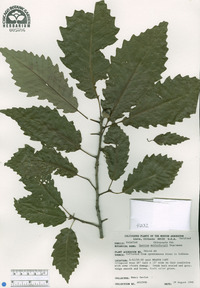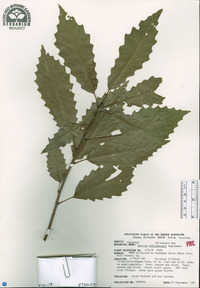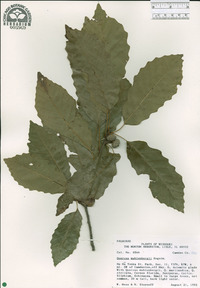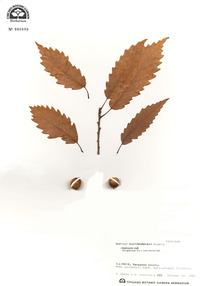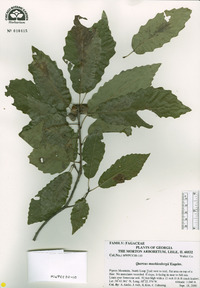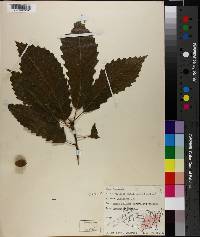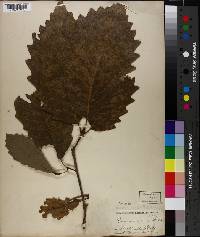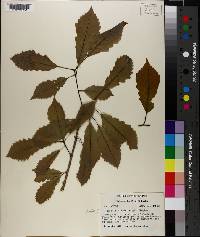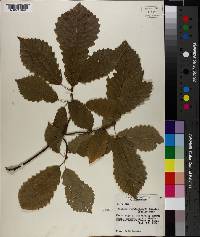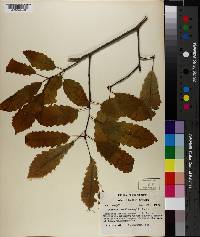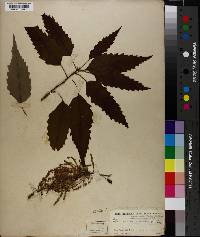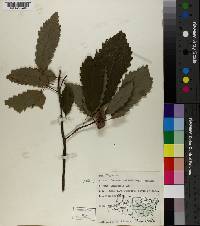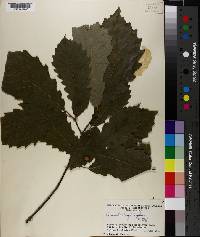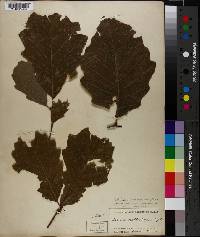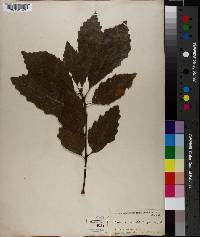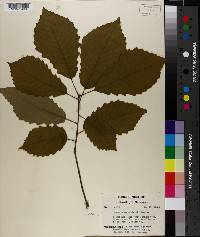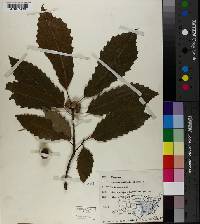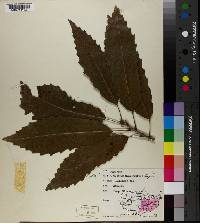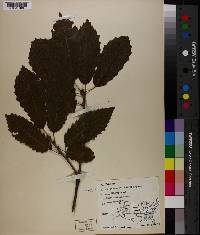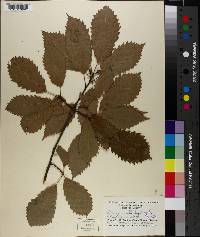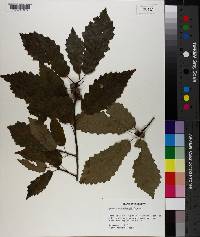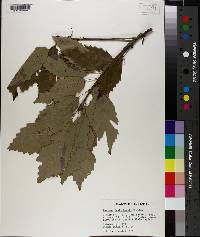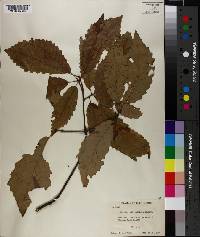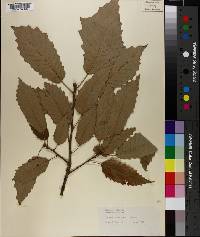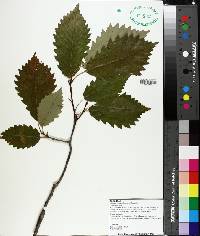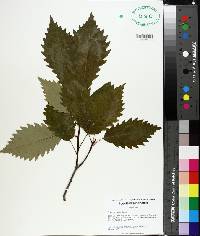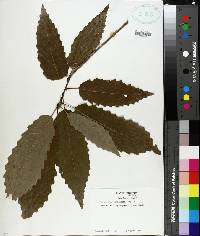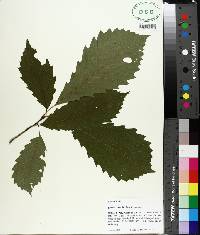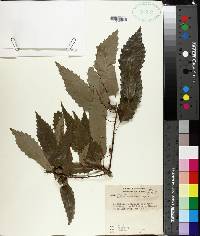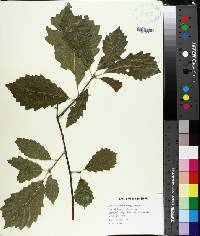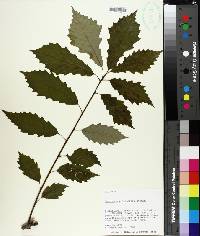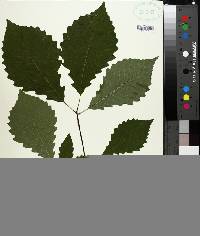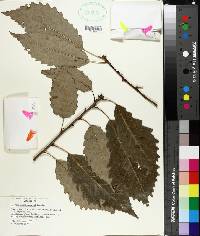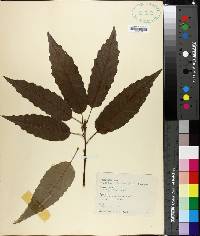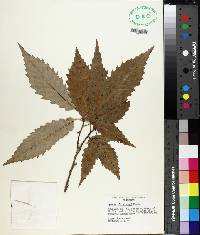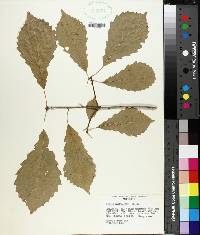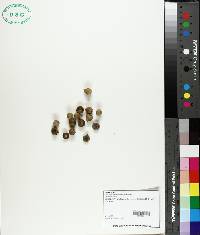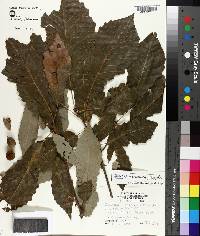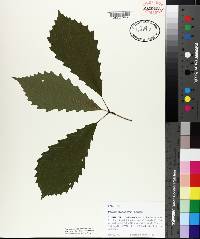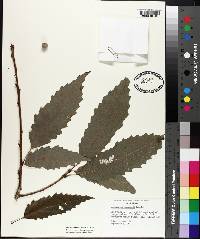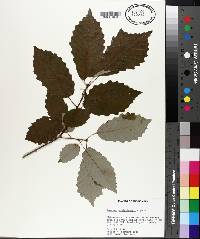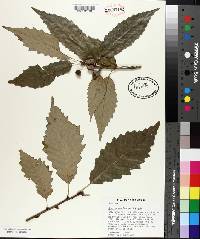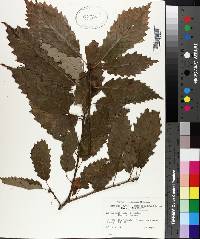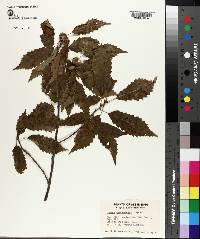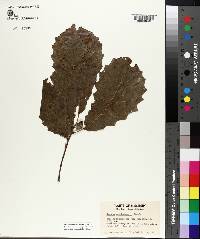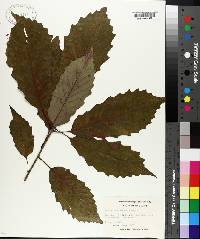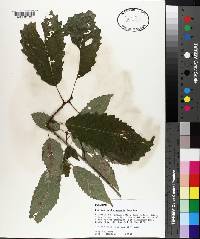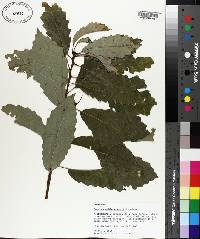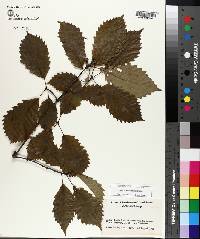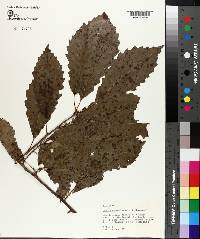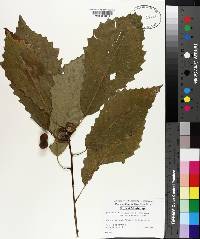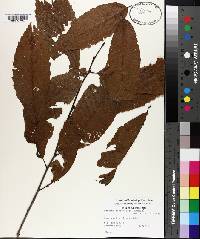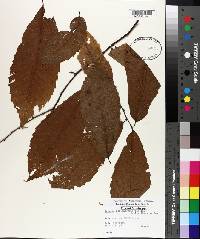Quercus muehlenbergii
|
|
|
|
Family: Fagaceae
Chinkapin Oak, more...chinquapin oak
[Quercus acuminata Roxb., moreQuercus acuminata var. alexanderi , Quercus alexanderi Britton, Quercus brayi , Quercus muehlenbergii f. alexanderi (Britton) Trel., Quercus muehlenbergii var. alexanderi (Farw.) Farw., Quercus muehlenbergii var. brayi (Small) Sarg., Quercus muhlenbergii Engelm., Quercus prinoides var. acuminata (Michx.) Gleason, Quercus prinoides var. rufescens Rehder] |
Trees , deciduous, moderate to large, to 30 m, occasionally large shrubs (ca. 3 m) on drier sites. Bark gray, thin, flaky to papery. Twigs brownish, 1.5-3(-4) mm diam., sparsely fine-pubescent, soon becoming glabrate, graying in 2d year. Buds brown to red-brown, subrotund to broadly ovoid, 20-40 × (10-)15-25 mm, apex rounded, very sparsely pubescent. Leaves: petiole (7-)10-30(-37) mm. Leaf blade usually obovate, sometimes lanceolate to oblanceolate, (32-)50-150(-210) × (10-)40-80(-106) mm, leathery, base truncate to cuneate, margins regularly undulate, toothed or shallow-lobed, teeth or lobes rounded, or acute-acuminate, often strongly antrorse, secondary veins usually (9-)10-14(-16) on each side, ± parallel, apex short-acute to acuminate or apiculate; surfaces abaxially glaucous or light green, appearing glabrate but with scattered or crowded minute, appressed, symmetric, 6-10-rayed stellate hairs, adaxially lustrous dark green, glabrate. Acorns 1-2, subsessile or on axillary peduncle to 8 mm; cup hemispheric or shallowly cupped, 4-12 mm deep × 8-22 mm wide, enclosing 1/4-1/2 nut, base rounded, margin usually thin, scales closely appressed, moderately to prominently tuberculate, uniformly short gray-pubescent; nut light brown, oblong to ovoid, (13-)15-20(-28) × l0-13(-16) mm. Cotyledons distinct. 2 n = 24. Flowering late winter-spring. Mixed deciduous forest, woodlands and thickets, sometimes restricted to n slopes and riparian habitats in w parts of range, limestone and calcareous soils, rarely on other substrates; 0-2300 m; Ont.; Ala., Ark., Conn., Fla., Ga., Ill., Ind., Iowa, Kans., Ky., La., Md., Mass., Mich., Minn., Miss., Mo., Nebr., N.J., N.Mex., N.Y., N.C., Ohio, Okla., Pa., S.C., Tenn., Tex., Vt., Va., W.Va., Wis.; Mexico (Coahuila, Nuevo León, Hidalgo, and Tamaulipas). Shrubby forms of Quercus muehlenbergii are difficult to distinguish from Quercus prinoides , but Q . muehlenbergii does not spread clonally or produce acorns on small shrubs as does Q . prinoides . The edaphic preferences of these two species are distinctive, with Q . muehlenbergii never far from limestone substrates and Q . prinoides occurring mostly on dry shales and deep sands. Populations of Q . muehlenbergii from the southwest part of its range, on the Edwards Plateau of Texas and westward, sometimes are segregated as Q . brayi Small, but the variation appears to be clinal with inconsistent differences. Distributed from Hidalgo, Mexico to Maine, Q . muehlenbergii is one of the most widespread species of temperate North American trees. The Delaware-Ontario prepared infusions from the bark of Quercus muehlenbergii to stop vomiting (D. E. Moerman 1986).
Tree 20 - 30 m tall, trunk to 1.3 m in diameter Leaves: alternate, stalked, yellowish green above, pale and hairy beneath, 10 - 18 cm long, 3 - 12.5 cm wide, tapering at both ends, coarsely to sharply toothed. Flowers: either male or female, found on the same tree (monoecious), light yellow male flowers are borne in hanging catkins 7 - 10 cm long, female flowers borne solitary or in small clusters near leaf axils. Fruit: an acorn, maturing in one season, solitary or in pairs. The stalkless or short-stalked, bowl-shaped cup covers one-quarter to half of the nut and has thickened, rounded, slightly fringed, hairy scales. Nut light brown and 1.2 - 2.5 cm long. Bark: silvery gray with narrow, flaking scales. Twigs: green and hairy, becoming yellowish brown to reddish brown and smooth. Buds: chestnut-brown, 4 - 6 mm long, conical. Each terminal bud is surrounded by a cluster of lateral buds. Form: broad and rounded. Similar species: Castanea dentata, Quercus muhlenbergii and Quercus montana have similar leaves. Castanea dentata leaves have sharply toothed margins with a vein extending into a bristle at the tip of each tooth, and the nuts are enclosed in a sharp, prickly bur that splits on four sides. The teeth of Q. montana leaves are somewhat rounded, the acorn is shiny, the twigs are orangish brown, and the bark is nearly black and fissured to furrowed. Flowering: May to June Habitat and ecology: Occasionally located on rocky, wooded slopes, limestone outcrops, or alkaline to neutral bottomlands. Occurence in the Chicago region: native Notes: Quercus muhlenbergii naturally hybridizes with Q. alba (Q. x deamii). Etymology: Quercus is the Latin name for oak. Muhlenbergii is named after Gotthilf Henry Ernest Muhlenberg (1753-1815), a Lutheran minister and botanist. Author: The Morton Arboretum Tall tree (to 25 m) with rather thin, gray, flaky bark; lvs densely pubescent or tomentose beneath with fine, horizontally spreading, grayish hairs, lanceolate to narrowly oblong, oblanceolate or obovate, 10-20 cm, broadly cuneate to rounded at base, with 9-14 veins on each side, the veins running straight to the teeth and nearly parallel, the teeth commonly sharp, ascending, and often incurved, each ending in a minute, papilliform projection; acorns sessile or nearly so, 1-2 cm, the cup 1-2 cm wide, its very numerous small scales free at the tip; nut ovoid. In good, chiefly calcareous soils; Vt. to se. Minn. and w. Nebr., s. to n. Fla., Ala., and Tex. (Q. prinoides var. acuminata) Gleason, Henry A. & Cronquist, Arthur J. 1991. Manual of vascular plants of northeastern United States and adjacent Canada. lxxv + 910 pp. ©The New York Botanical Garden. All rights reserved. Used by permission. From Flora of Indiana (1940) by Charles C. Deam In northern Indiana this species is called sweet oak. Infrequent to rare in all parts of the state although Hill's report from Lake County is the only one from the northwestern part. It is generally found on the dry banks of streams, river terraces, rocky, wooded bluffs, and only rarely in level, moist woods. …… Indiana Coefficient of Conservatism: C = 4 Wetland Indicator Status: FACU Deam (1932): Wood similar to white oak and with the same uses. In White County a pioneer was found who knew the tree only by the name of pigeon oak. He said it received this name from the fact that wild pigeons were fond of the acorns. |
|
|
|

